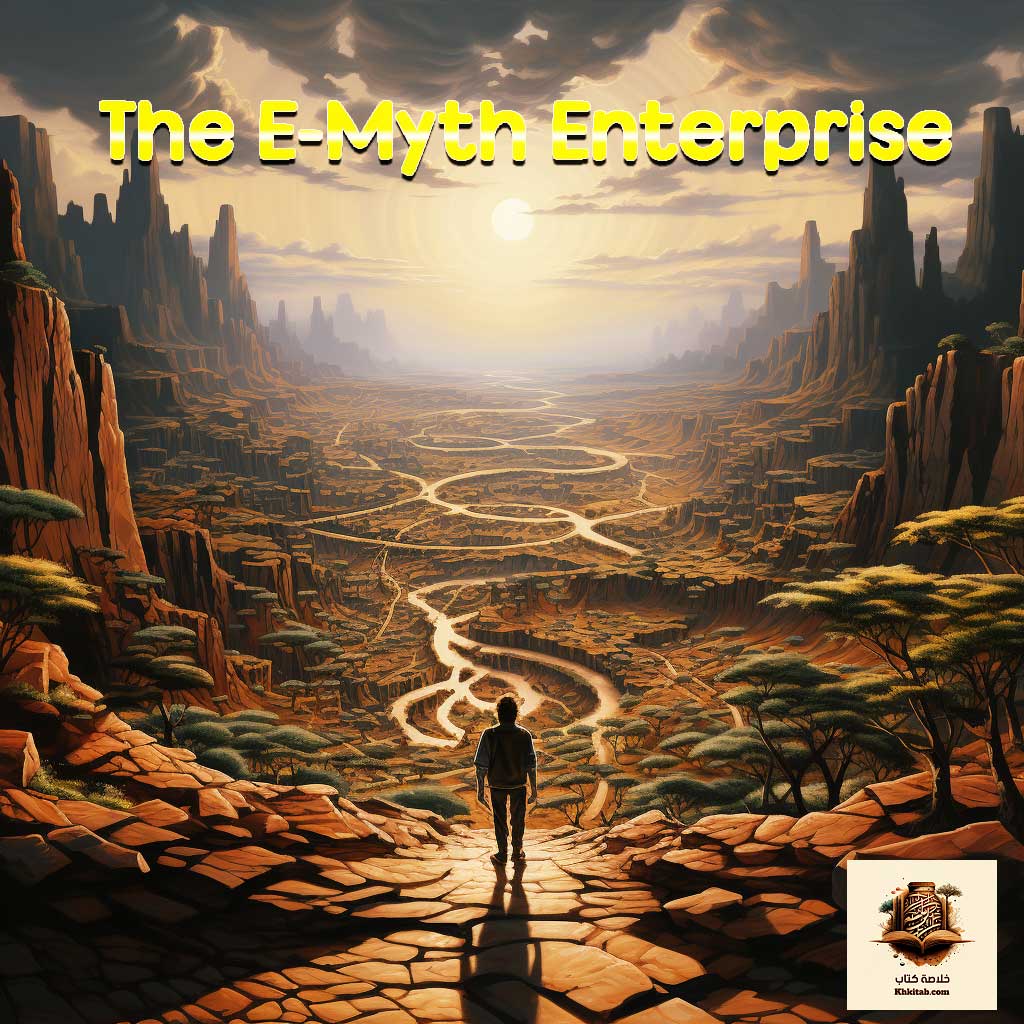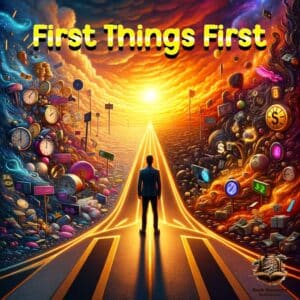The E-Myth Enterprise Book Summary

In today’s entrepreneurial landscape, navigating the path to success and sustainability is paramount. “The E-Myth” emerges as a seminal work, offering an in-depth perspective on what sets certain ventures apart for success while others falter. This book is not merely a guide on business management; it presents a groundbreaking vision that goes beyond traditional advice.
Author Michael E. Gerber introduces a captivating concept about the underlying reasons many small businesses fail and how budding entrepreneurs can sidestep these common pitfalls. By dissecting the tripartite role every entrepreneur must play – the Technician, the Businessman, and the Manager – Gerber illuminates the proper path to laying a strong, sustainable foundation for any enterprise.
“The E-Myth” stands as a cornerstone text every entrepreneur should delve into. Bridging theoretical insights with practical applications, the book furnishes tools and strategies to surmount challenges and craft a successful venture under varying circumstances.
If you’re seeking inspiration or guidance on your entrepreneurial journey, “The E-Myth” promises to be your guiding beacon, illuminating the way.
Is Every Business Owner Truly an Entrepreneur? Unraveling the Entrepreneurial Myth in ‘The E-Myth Enterprise’
In the modern business landscape, a myriad of individuals dives into the realm of entrepreneurship with a dream to make it big. ‘The E-Myth Enterprise: How to Turn a Great Idea into a Thriving Business’ by Michael E. Gerber critically examines this very trajectory. One of the pivotal insights from the book revolves around the ‘Entrepreneurial Myth’ – a notion that has long been misunderstood.
This myth hinges on the belief that every individual who starts a business is inherently an entrepreneur. However, as Gerber delineates, this is far from the truth. Not every business owner possesses the innovative spirit, the foresight, or the risk-taking appetite that are the hallmarks of a true entrepreneur. Some might be better described as managers, excelling in day-to-day operations, while others might fit the technician mold, specializing in the nitty-gritty of their trade.
The book posits that understanding this differentiation is crucial. Recognizing one’s strengths and weaknesses enables business owners to surround themselves with complementary skills, thereby bolstering their venture’s chances of success. For instance, a technician might be excellent at crafting a product but might struggle with scaling the business or navigating the market dynamics.
Gerber’s ‘The E-Myth Enterprise’ thus serves as a reflective mirror for business owners. It encourages them to introspect, assess their true role in their business, and then make informed decisions to ensure the longevity and success of their enterprise. In a world where start-up culture romanticizes the idea of entrepreneurship, this book offers a grounded, realistic look into what being an entrepreneur truly entails.
Our Facebook Page – Book Summary
How Do the Three Personalities – Technician, Manager, and Entrepreneur – Shape Business Success in ‘The E-Myth Enterprise’?
In the realm of entrepreneurship, success isn’t solely about a brilliant idea or an innovative product; it’s as much about the people driving the vision forward. Michael E. Gerber’s acclaimed work, “The E-Myth Enterprise: How to Turn a Great Idea into a Thriving Business,” dives deeply into this very notion, suggesting that within every business owner, there are three distinct personalities – The Technician, the Manager, and the Entrepreneur.
At the heart of Gerber’s argument is the idea that these three personas often coexist within a single business owner, each vying for dominance, and each bringing its unique strengths and challenges. The Technician is the doer, hands-on and immersed in the daily tasks, with a penchant for the specifics. They thrive in the nitty-gritty and excel in their craft, but can sometimes get bogged down by the operational intricacies without looking at the bigger picture.
Then there’s the Manager, the organizer and the planner. This persona is pragmatic, ensuring that day-to-day operations run smoothly. They set the schedules, oversee the teams, and maintain the order. While their systematic approach is essential for stability, they may at times be resistant to drastic changes or bold new directions.
Lastly, the Entrepreneur is the dreamer, the visionary. Always looking towards the horizon, they’re driven by what could be, rather than what is. Their role is to keep the business evolving, innovating, and moving forward. However, left unchecked, they might risk pursuing new ventures at the cost of the current business’s stability.
Understanding the interplay of these personas and ensuring they are in balance is key. “The E-Myth Enterprise” posits that for a business to truly flourish, business owners need to recognize when to wear each hat and how to harmoniously integrate these personalities. By embracing the Technician’s precision, the Manager’s order, and the Entrepreneur’s vision, business owners can better navigate the complex journey from a mere idea to a thriving enterprise.
Business & Finance Management – Book Summary (khkitab.com)
How Does ‘The E-Myth Enterprise’ Distinguish Between Working ON Your Business and Working IN It?
Within the dynamic landscape of business and entrepreneurship, mastering the art of effective management is crucial. Michael E. Gerber’s “The E-Myth Enterprise: How to Turn a Great Idea into a Thriving Business” delves into this concept, elucidating the difference between working ON your business versus working IN it. This distinction is foundational for those aspiring to grow and scale their ventures effectively.
At its core, working IN the business pertains to the day-to-day operational tasks. This involves managing staff, handling customer inquiries, overseeing the nitty-gritty of the daily operations, and ensuring that the workflow remains smooth. It’s about the immediate, tangible duties that keep the business running from one day to the next. Often, business owners, especially in startups or small businesses, find themselves entrenched in this mode, acting more as technicians or managers.
On the other hand, working ON the business relates to the overarching strategy and vision of the company. It’s about setting long-term goals, market positioning, innovating, scaling, and steering the business towards a bigger picture. This requires an entrepreneurial mindset, a forward-looking perspective that envisions where the business should be in the next five, ten, or even twenty years.
Gerber’s “The E-Myth Enterprise” emphasizes that while both aspects are essential, it’s pivotal for business owners to strike a balance. Neglecting the day-to-day can lead to operational chaos, while failing to focus on the bigger picture can stunt growth and opportunity. The true essence of a thriving business lies in seamlessly integrating these dual roles, allowing for both immediate efficiency and long-term vision. As the book suggests, to truly turn a great idea into a prosperous enterprise, this balance between the micro and macro perspectives is non-negotiable.
How Does ‘The E-Myth Enterprise’ Emphasize the Role of Systems in Transforming a Business Idea into a Successful Venture?
In the vast arena of business literature, Michael E. Gerber’s “The E-Myth Enterprise: How to Turn a Great Idea into a Thriving Business” stands out, particularly when addressing the role of systems in efficient business operations. The concept of establishing consistent and repeatable processes isn’t merely a suggestion in the book; it’s portrayed as the backbone of a flourishing enterprise.
In the modern business landscape, where competition is fierce and the margin for error is slim, reliance on ad-hoc methods or improvisation can jeopardize an enterprise’s very survival. Gerber illuminates this through his emphasis on the ‘Importance of Systems.’ A well-structured system provides clarity, reduces redundancy, and ensures that every team member is aligned towards a unified goal, irrespective of their role or hierarchy in the organization.
The ‘system-thinking’ approach is about anticipating challenges and setting protocols in place to address them efficiently. It’s not merely about task completion but about achieving desired outcomes with consistency. For instance, while two staff members might achieve the same result through different methods, without a consistent system, the outcome’s quality and efficiency can vary greatly, leading to unpredictability in business operations.
Moreover, Gerber touches upon how systems pave the way for scalability. A well-oiled, systematic operation allows for smooth replication across different branches, franchises, or even when diversifying into new business areas. This consistent approach ensures that the brand’s quality and values remain intact irrespective of its size or geographical spread.
In conclusion, “The E-Myth Enterprise” serves as a clarion call for entrepreneurs to recognize that while a brilliant idea sets the stage, it’s the systematic execution of that idea that truly determines success. Without robust, consistent, and repeatable systems in place, even the most promising of business ideas might flounder. But with them, that very idea has the potential to transform into a thriving, expansive enterprise.
How Does ‘The E-Myth Enterprise’ Advocate the Franchise Prototype as the Blueprint for Scalable Business Success?
Navigating through the intricate ecosystem of modern entrepreneurship, Michael E. Gerber’s “The E-Myth Enterprise: How to Turn a Great Idea into a Thriving Business” stands as a beacon of insight, particularly with its emphasis on the Franchise Prototype. This strategy, deeply explored in the book, proposes the adoption of franchising principles as the means to sculpt a business that’s both scalable and replicable, regardless of the intention to actually franchise.
The crux of the Franchise Prototype lies in standardization. In the world of fast-food chains, for instance, regardless of which city, state, or country you’re in, you’ll often experience consistent quality and service. This consistency is no accident; it’s the result of meticulously crafted systems, processes, and training. Gerber argues that businesses, regardless of their industry, can benefit from such a structured approach.
Adopting the principles of a Franchise Prototype entails building a business model that’s not overly reliant on exceptional talent or unique circumstances. Instead, it’s about creating a well-documented, easily replicable system that delivers consistent results. This doesn’t mean stifling innovation or creativity but channeling them within the parameters of a proven model.
One significant advantage, as highlighted in “The E-Myth Enterprise”, is the ease of scalability. With a functional prototype in place, expanding becomes less about reinventing the wheel and more about deploying a tried-and-tested model in new locations or markets. Such a method reduces the risks typically associated with expansion and ensures that the brand’s identity remains consistent across all touchpoints.
Furthermore, the Franchise Prototype encourages an objective review of the business. By viewing the enterprise as a product that can be franchised, business owners are nudged to iron out inefficiencies, streamline processes, and ensure that the business can function optimally even in their absence.
In sum, while not every business may aim to become a franchise, Gerber’s proposition in “The E-Myth Enterprise” is that every business can benefit from thinking like one. By implementing the principles of the Franchise Prototype, companies can foster a sustainable, scalable, and consistent model primed for success in today’s competitive landscape.
How Does ‘The E-Myth Enterprise’ Chart the Journey of Business Growth from Infancy to Maturity?
In “The E-Myth Enterprise: How to Turn a Great Idea into a Thriving Business,” Michael E. Gerber provides readers with a deep dive into the evolutionary stages a business undergoes, illustrating the transition from its initial inception (infancy) through the tumultuous period of adolescence and finally, arriving at maturity. Understanding these phases and the unique challenges each presents is instrumental in steering a business towards sustainable success.
1. Infancy:
This is the genesis of the business where the owner and the business are virtually synonymous. At this stage, the owner is the business. Decision-making is swift, driven mostly by instinct and immediate needs. While this phase brims with enthusiasm, it’s also fraught with makeshift approaches and spontaneous decisions. The emphasis is more on survival and ensuring day-to-day operations run, rather than long-term strategies. If businesses remain in this phase for too long, they risk stagnation or burnout.
2. Adolescence:
Here, the business begins to grow, often outpacing the owner’s capability to manage every aspect directly. It’s a critical juncture where delegation becomes vital. However, it’s also where many businesses falter, as relinquishing control can be challenging. Systems and processes begin to take shape, and hiring becomes more strategic. Yet, this phase can also be marked by missteps and growing pains. An owner might resist necessary changes, leading to internal conflicts, or the business might expand faster than its infrastructure can support.
3. Maturity:
When a business reaches maturity, it has established systems in place, a clear brand identity, and a set vision for the future. The owner can step back from daily operations, focusing more on strategic growth and innovation. At this stage, the business has a life of its own, with a stable team driving its operations. The company is now more resilient, capable of weathering challenges, and poised for future expansion.
In conclusion, “The E-Myth Enterprise” serves as both a guide and a cautionary tale. Gerber emphasizes that understanding and recognizing these stages, with their respective challenges and opportunities, is key for any business owner aiming to transform a fledgling idea into a thriving, mature enterprise. By addressing each phase with the right strategies, tools, and mindset, entrepreneurs can navigate the treacherous waters of business growth and lead their ventures to lasting success.
How Does ‘The E-Myth Enterprise’ Guide Entrepreneurs in Creating a Robust Strategic Objective for Business Success?
One of the foundational elements discussed by Michael E. Gerber in “The E-Myth Enterprise: How to Turn a Great Idea into a Thriving Business” is the significance of a strategic objective. This isn’t just a mere goal or a vague ambition; it’s a vivid portrayal of the desired future of a business and the articulated pathway to manifest that vision.
1. The Visionary Canvas:
Gerber emphasizes the necessity for entrepreneurs to be visionaries. Before diving into daily operations or setting sales targets, one must have a grand vision. This vision is the beacon, illuminating the entrepreneur’s path in the darkest hours, keeping the purpose and direction clear.
2. Tangibility in Abstract Goals:
While visions can be abstract, the strategic objective refines them into tangible milestones. It takes the broader picture and breaks it down into actionable steps, making the journey towards that end-goal systematic and achievable.
3. Alignment with Core Values:
A strategic objective isn’t just about financial milestones or market shares. Gerber stresses the importance of aligning the objective with the company’s core values and culture. This ensures the business remains true to its identity, regardless of external pressures or fleeting market trends.
4. Flexibility & Adaptability:
While it’s crucial to have a clear strategic objective, it’s equally vital to ensure there’s room for adaptability. Markets change, technologies evolve, and consumer preferences shift. A robust strategic objective provides a framework but also allows for adjustments based on real-world feedback and changing scenarios.
5. Continuous Review and Refinement:
The journey to realizing a business’s full potential is not static. Gerber suggests periodic reviews of the strategic objective, gauging the business’s trajectory, and making necessary pivots or refinements to stay aligned with the ultimate vision.
In essence, “The E-Myth Enterprise” provides a roadmap for entrepreneurs, emphasizing the importance of a well-defined strategic objective. This objective serves as both a destination and a compass, ensuring the business navigates its journey with purpose, clarity, and resilience. Gerber’s insights inspire businesses to not just chase short-term gains but to carve out a legacy built on vision, values, and strategic foresight.
How Does ‘The E-Myth Enterprise’ Emphasize Effective Management Strategy for Business Growth?
In “The E-Myth Enterprise: How to Turn a Great Idea into a Thriving Business,” Michael E. Gerber distinctly underscores the vital role of a well-articulated management strategy in fostering business success. Delving deeper into the layers of effective management, Gerber demonstrates how it transcends beyond traditional operational roles and dives into the heart of producing consistent, desired outcomes.
1. The Backbone of Operational Systems:
Gerber emphasizes that businesses cannot thrive on spontaneity alone. There’s an essential need for structured operational systems that provide a standardized method of accomplishing tasks. These systems reduce ambiguity, ensure uniformity, and optimize efficiency, paving the path for scalability.
2. Comprehensive Training:
It’s not enough to just have systems in place; the team must know how to execute them correctly. Gerber points out the necessity of robust training programs tailored to fit individual roles within the organization. By ensuring that every team member is equipped with the requisite knowledge and skills, businesses can achieve consistent results and maintain quality standards.
3. Ensuring Consistency:
For Gerber, consistency isn’t merely about repetition but about excellence in repetition. An effective management strategy aims for consistency in delivering desired results, ensuring that the brand promise is upheld every time, building trust and reliability among consumers.
4. Feedback Loops and Continuous Improvement:
Management isn’t a set-it-and-forget-it deal. Gerber accentuates the value of feedback mechanisms to continually refine and adapt processes. By regularly evaluating performance against set benchmarks, businesses can identify gaps, innovate, and evolve to meet changing market dynamics.
5. The Role of Leadership:
While systems, training, and feedback are crucial, Gerber also touches upon the indispensable role of leadership in management strategy. Leaders should embody the business’s vision, motivate the team, and set the tone for a culture of excellence.
In conclusion, “The E-Myth Enterprise” offers a holistic view of management strategy, presenting it as a dynamic blend of systems, training, feedback, consistency, and leadership. Gerber’s insights serve as a beacon for entrepreneurs seeking to transform their great ideas into thriving, sustainable businesses, underscoring the essence of effective management in this transformative journey.
How Does ‘The E-Myth Enterprise’ Stress the Significance of People Development in Achieving Business Success?
Michael E. Gerber’s “The E-Myth Enterprise: How to Turn a Great Idea into a Thriving Business” is a profound resource that delves deep into the intricacies of developing a successful business. Amidst its invaluable insights, a standout emphasis is on the essence of people development. This involves the nurturing and growth of your team, which Gerber argues, leads directly to the thriving success of any business.
1. Human Assets Over Monetary Assets:
Gerber makes it clear that while financial assets are crucial, the real value lies in human assets. Investing in your team, offering them opportunities for growth, and supporting their career trajectories add more long-term value to a business than any immediate monetary gain.
2. Continuous Learning and Growth:
In an ever-evolving business landscape, stagnation can be detrimental. The book highlights the importance of continuous learning, urging businesses to promote a culture where employees are encouraged to upskill, attend workshops, or undertake courses that enhance their competencies.
3. Mentorship and Guidance:
Having senior members or mentors to guide newer or less experienced employees can be invaluable. Gerber talks about the transformational power of mentorship, both in terms of skill acquisition and building a cohesive team ethos.
4. Recognizing and Rewarding:
For people to feel truly invested in a business’s vision, they need to feel valued. “The E-Myth Enterprise” underscores the importance of recognizing employees’ efforts and rewarding them appropriately. This not only boosts morale but also promotes a culture of excellence.
5. Constructive Feedback:
Development is not just about praise; it’s also about constructive criticism. Gerber emphasizes the need for regular feedback sessions where employees can understand their strengths and areas of improvement, fostering a culture of continuous growth.
6. Fostering Leadership:
Every team member has the potential to be a leader in their domain. Gerber’s insights encourage businesses to recognize and nurture these leadership qualities, preparing the business for future challenges and ensuring continuity.
In summary, “The E-Myth Enterprise” presents a compelling case for businesses to prioritize people development as a core strategy. Gerber’s approach posits that a nurtured and well-developed team not only drives operational success but also shapes the very culture and ethos of a thriving business. In the grand scheme, it’s the people that make or break a business, and this book serves as a testament to that philosophy.
How Does ‘The E-Myth Enterprise’ Emphasize the Role of Innovation, Quantification, and Orchestration in Building a Thriving Business?
Michael E. Gerber’s “The E-Myth Enterprise: How to Turn a Great Idea into a Thriving Business” is a comprehensive guide that dissects the core principles essential for any successful business. Among the key concepts, the trio of Innovation, Quantification, and Orchestration stands out, each playing a pivotal role in the growth and sustainability of a business.
1. Innovation:
At the heart of any thriving business is the spirit of innovation. Gerber stresses that companies must consistently reinvent their processes, products, or services to meet the ever-evolving needs of their customers. However, innovation isn’t about change for change’s sake. It’s about addressing gaps, foreseeing market trends, and proactively meeting demands. This keeps the business relevant and ahead of its competitors.
2. Quantification:
Innovation’s impact can only be gauged if its results are measurable. Quantification, as Gerber explains, is about setting benchmarks, tracking performance, and interpreting numbers. A business should be data-driven. By continually measuring results, businesses can assess the effectiveness of their innovations, making necessary adjustments to ensure they’re on the path to achieving their strategic objectives.
3. Orchestration:
While innovation introduces new methods and quantification measures their effectiveness, orchestration ensures consistency in the delivery of products or services. Gerber emphasizes that customers expect a consistent experience, and businesses need to ensure that their innovations can be replicated consistently across all touchpoints. Orchestration ties the loose ends, making sure that every aspect of the business operation is synchronized, creating a seamless and predictable experience for the customer.
In summary, “The E-Myth Enterprise” paints a vivid picture of a successful business framework where Innovation breathes life into the business model, Quantification provides the analytical lens to assess progress, and Orchestration guarantees that the business delivers consistently. Together, these principles create a cohesive strategy that not only ensures the survival of a business but also paves the way for its thriving success. For businesses aiming to scale and remain relevant, mastering these three pillars is paramount.


